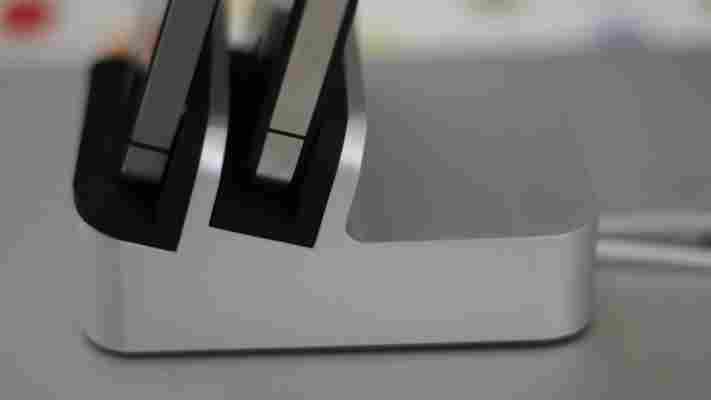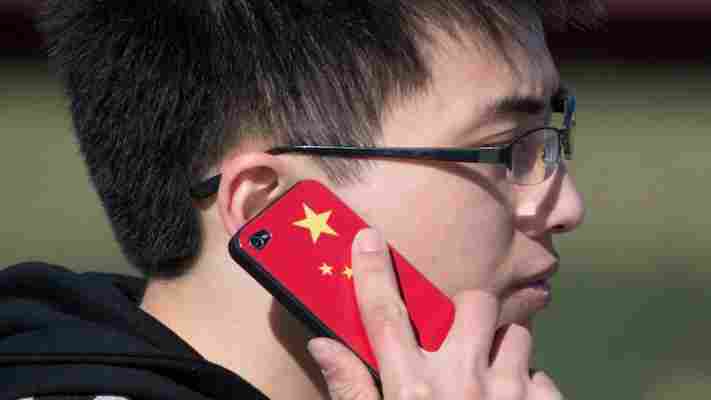I’ve never been able to get into 3D movies and TVs because fitting 3D specs over my prescription glasses never worked. EyeFly3D created a screen protector that can display stereoscopic content on your iPhone, iPad and Nexus 7 without having to use those pesky glasses.

The iPhone protector will set you back $26.95 , while preorders for the iPad Air version cost $59.95 . Creator Nanoveu announced an iPad mini and Nexus 7 version at CES, but it hasn’t begun taking orders for them yet.
The product works by incorporating 500,000 nano-lenses onto the screen protector in order to provide your left and right eye with the images necessary to create the stereoscopic effect.
Installing the screen protector is slightly more difficult than applying a standard film, as you’ll have to use the EyeFly3D app to align it. The app projects an image of lines that you’ll need to adjust as vertical before sticking on the protector. You can use the included piece of tape to act as a hinge once you’ve got things aligned.
EyeFly3D advertises its product as “bubble-free,” but I still ended up with a couple of unsightly bubbles even after multiple attempts. It’s not much of an issue when the screen is on, but the bubbles stare back at me mockingly when the phone is off. That being said, I’m terrible at applying screen protectors, so you might have the patience and dexterity needed to get one on without any blemishes.
To view 3D content, you can use the EyeFly3D Vid and Img apps. You can turn 2D video and images from your camera roll into 3D, but I wouldn’t recommend it. The end result usually looked worse than the original.
Vid has a search function that lets you pull in 3D videos from the Web. You won’t find a ton of great stuff on there, but you can watch a couple movie trailers and a few demos.
You can also load 3D videos onto your iOS device using the File Sharing featuring in iTunes. In my experience, there isn’t much 3D digital content available legally, and you’d need a tremendous amount of space on your mobile device to load up a 3D movie anyway.
Future versions of the Img app will include the ability to create your own 3D images by designating which areas of a picture are the foreground, which are the middle
EyeFly3D claims that it doesn’t affect your normal 2D usage of the device. I’ve noticed a bit of jagging on text and icons when viewing my phone up close. Polarization isn’t significantly worse than some other screen protectors I’ve used, but it is noticeable.
3D video has improved in recent years, but it still hasn’t shaken its reputation for being a gimmick. EyeFly3D takes a step forward by removing the dorky glasses, but it lacks a fully-developed platform for streaming or downloading interesting 3D content. I’d consider paying $27 for an iPhone screen protector that also happens to do 3D, but I’d wait for content to catch up before paying $60 for the iPad version.
➤ Eyefly3d
Hands-on with the EverDock, a slick universal dock for smartphones and tablets
Fuz Design’s EverDock lets you dock all kinds of devices, and it looks good while doing it. The Kickstarter project , which wraps up on Thursday, has an attractive aluminum design that matches Apple’s aesthetics.

The dock will come in single and double versions and is fitted for Lightning, 30-pin dock and micro-USB connectors. It includes silicone protectors if you’re using your device bare, or you can take the pads off if you have a case.
The sample we were sent didn’t include the customized micro-USB cable, so I wasn’t able to get a perfect fit for a Moto X, but it worked fine with an iPhone 5s, iPhone 4s and iPad 2.
Unfortunately, threading the cables underneath the dock wasn’t a perfect fit on the dual-device model, as the slot for the front device is slightly off-center. It was possible to make it work with some fussing, but if I wasn’t careful, the cable would either stick out and keep the dock from lying flat or the connector would poke up and keep the device from sitting flush with the dock. The single-device version shouldn’t have this problem, as the cable slot is centered with the docking port.
Update: Fuz Design responded that the cable fits if pulled tight before tucking into the slot. I expressed concern about keeping the cable at an angle for exended periods of time, but co-founder Cameron Gibbs said that cables have held up during testing and actually receive less wear and tear since they’re stationary and not being pulled around.
The EverDock’s micro-suction pads served to keep it in place without making it difficult to move. I did a quick test of sticking the dock to a surface and holding it upside-down in the air, and it managed to keep its grip and hold two iPhones in place.
The dock comes in silver, space gray and gold, so it’s best-matched for iPhones and iPads. Backers who pledge at least $49 will receive the single-device version, while a $69 pledge will include the Everdock Duo as a reward. The two models will retail for $69 and $89, respectively, once they go on sale.
If you’re interested in backing more crowdfunded smartphone docks, take a look at the Sarvi Dock and the Spool Dock projects.
➤ EverDock [Kickstarter]
Chinese smartphones could be helping to ease the ‘Made in China’ stigma
Made in China — what impression does that give you?

If the first thought that comes into your mind is a negative one, you’re probably not alone. “Made in China” is a stigma that comes along with a historical lack of quality control by manufacturers, which have made consumers lose trust in pretty much anything made in the country.
After all, who could ever forget the 2008 Chinese milk scandal — in which melamine was added to milk and infant formula — resulting in an estimated 300,000 victims?
This stigma has trickled down to smartphones, and even applies to rising Chinese smartphone manufacturer Xiaomi . Even though Xiaomi has raised its profile worldwide recently by showing people from all over the world exactly how popular it is in the world’s largest smartphone market, in the several pieces we have written about the company, inevitably a comment or two will contain some derision over the fact that it is “made in China”.
This is likely why Xiaomi is so insistent on releasing its smartphones in batches as that gives them more control over any quality issues. Although Xiaomi’s decision to do so has led to a whole load of criticism over creating artificial demand and short supply, the company hasn’t given up on its way of doing things.
Jenny Lee, a partner at venture capital firm GGV Capital which has a presence in both the US and China, recently told TNW that it will take plenty of time for low-quality products to get weeded out from the market, and for Chinese products to lose the stigma attached to them currently.
Is 2013 the year that smartphone manufacturers are taking big strides in shedding the “made in China” stigma?
Chinese handset maker Oppo may be best-placed to answer that — or rather Oppo’s vice-president Pete Lau, who announced on Twitter-like microblogging platform Sina Weibo that he is resigning from Oppo, amid rumors ( reported by Sina Tech ) that he is planning to set up another smartphone brand that will likely be launched early next year.
By selecting this particular time to launch an entirely new Chinese smartphone brand hints at the fact that Chinese device manufacturers are much more confident in creating products that consumers can trust in. In other words, the road has been well-paved.
Oppo was founded in 2004 as an electronics manufacturer, but this year, it has rolled out smartphones in quick succession that have top-of-the-line specs worth boasting about. We noted that the Find 5, unveiled late last year , was one of the most well-built phones we’ve seen come out of China. In September, Oppo took the wraps off N1, its latest flagship smartphone with a camera constructed from 67 different components, which it claims is the first to feature a six-piece lens design in an Android smartphone.
On his Weibo, Lau says that he recently met Cyanogen co-founder and CTO Steve Kondik to discuss the future of the third-party Android replacement firmware. Last week, Kondik said in a Google+ update that the meeting with Lau was to discuss their “vision for a phone that would fuse truly amazing software with the highest quality hardware available” — and that they are setting out to create that product.
CyanogenMod was created by Steve “Cyanogen” Kondik, providing Android handset owners with customized third-party Android software that is designed to increase performance and reliability over official releases by Google and mobile operators around the world.
The community has often helped Android smartphone owners install newer updates on their phones when operators have been reluctant to deliver updates, offering a barebones build of the software but delivering more powerful tweaks.
If a new phone from China successfully manages to marry this software with high-quality hardware, it could seriously be a game-changer and may be a great stride forward in erasing the “made in China” stigma.
Other than Xiaomi and Oppo which have worked hard at trying to reverse the negative “made in China” mindset among consumers, other smartphone manufacturers worth looking out for are Huawei , Lenovo , Coolpad and Meizu .
Analyst firm Canalys recorded that over a quarter of a billion smartphones shipped in Q3 2013 , a 44 percent year-over-year increase. Samsung and Apple managed to maintain their positions for smartphone shipments in Q3 2013, with market shares of 34 percent and 15 percent, respectively — but what’s more interesting is that Huawei, Lenovo and LG rounded out the top five.
Some may argue that this is because China is the world’s largest smartphone market and it is therefore not very accurate to determine that Chinese smartphone brands are being increasingly viewed as less unreliable purchases — considering that native consumers will probably veer towards domestic brands.
However, even the Chinese themselves can be picky buyers of smartphones — Apple has been doing well as it turned things around in China in Q4 FY2013. For the Chinese to accept homegrown brands is as good an indicator as any that perhaps the “made in China” stigma is slowly being eased — and there is much to watch out for in terms of new Chinese-made smartphones in the coming year.
Headline image via Ed Jones/AFP/Getty Images , images via Xiaomi, Oppo and Getty Images
